
Kotlin "returns" to the Top 20!
Last month, Julia broke into the Top 20 list for the first time in history, and received expectations from TIOBE CEO Paul Jansen: It is very exciting to see whether Julia can maintain and improve its ranking in the future. However, this month, Julia’s This position was replaced by Kotlin.
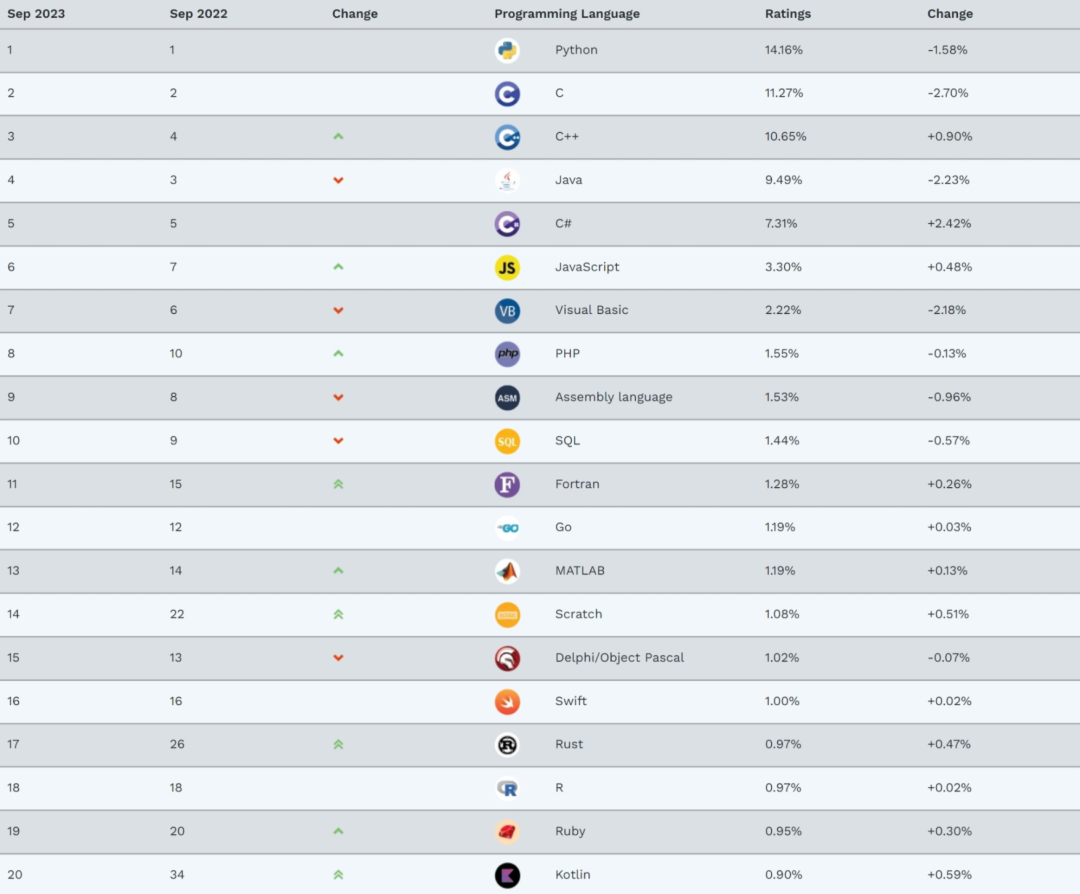
Like Java, Kotlin is also a programming language used for Android application development. As a rising star that was only officially released in 2016, it once shaken many programmers' determination and preference for Java.
In 2016, JetBrains officially released the Kotlin language for the first time. Less than a year later, Google announced at the Google I/O conference that Kotlin is supported in the Android Studio IDE, making Kotlin the second programming language officially supported by Android. Since then, the war between Java and Kotlin has become increasingly fierce.
As the traditional development language of Android, Java has gradually formed a very complete ecosystem after many years of development. There are many related open source projects, open source tools and large communities. It is also object-oriented and has good cross-platform portability. , is the "best programming language" in the minds of many programmers. However, Java is not perfect. For example, the code is too lengthy, slow, and the syntax is relatively complex, which has also discouraged many developers. In this context, Kotlin came into being.
Kotlin's concise syntax and modern syntax features not only make the code blocks it writes smaller and greatly improve development efficiency, but its high compatibility with Java also allows it to be used universally with libraries and frameworks made in Java. In addition, higher security and ease of maintenance have also attracted many people to switch to Kotlin. As Paul Jansen said: Code written in Kotlin is friendlier, faster and easier than code written in Java.
Therefore, Kotlin's popularity skyrocketed shortly after it came out. With the official support of Google, it occupied nearly 1% of the market share in 2017 and firmly occupied a place in the Top 20 list.

Regarding Kotlin's entry into the Top 20 again, TIOBE CEO Paul Jansen believes that Kotlin's rise may be more powerful this time because its user base is no longer the size it was in 2017 after these six years.
"Kotlin is a fierce competitor to Java, it outperforms Java in almost every aspect. The main argument against Kotlin is that Java is a more mature language and therefore has more programmers, books, training courses, libraries Wait." Paul Jansen said that he is looking forward to whether Kotlin can continue to maintain its position in the top 20 in the next few months.

Other programming languages
The following is the list of Top 21-50 programming languages:
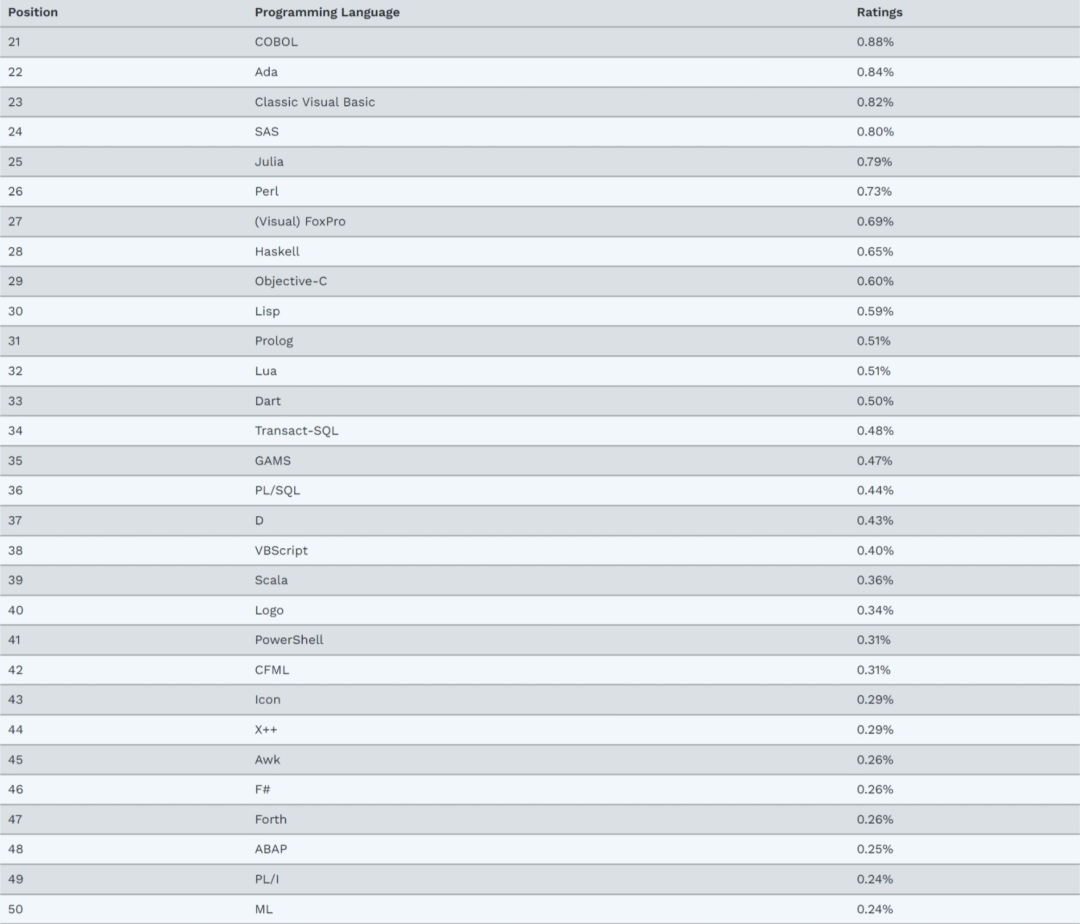
Numbers 51-100 are as follows, listed in text form only (in alphabetical order) due to the small numerical differences between them:
- 4th Dimension/4D, ABC, ActionScript, Algol, Alice, Apex, APL, Bash, bc, Boo, Bourne shell, Carbon, CHILL, CL (OS/400), CLIPS, Clojure, Crystal, Eiffel, Elixir, Elm, Erlang, Groovy, Hack, Inform, Io, J, J#, LabVIEW, Ladder Logic, Maple, Modula-2, Monkey, MQL5, NATURAL, Nim, OCaml, OpenEdge ABL, Pure Data, Q, Racket, Raku, RPG, Scheme, Smalltalk, Solidity, SPARK, TOM, TypeScript, VHDL, Wolfram

Top 10 Programming Language TIOBE Index Trend (2002-2023)


Historical ranking (1988-2023)
Note: The following rankings are based on 12-month averages.
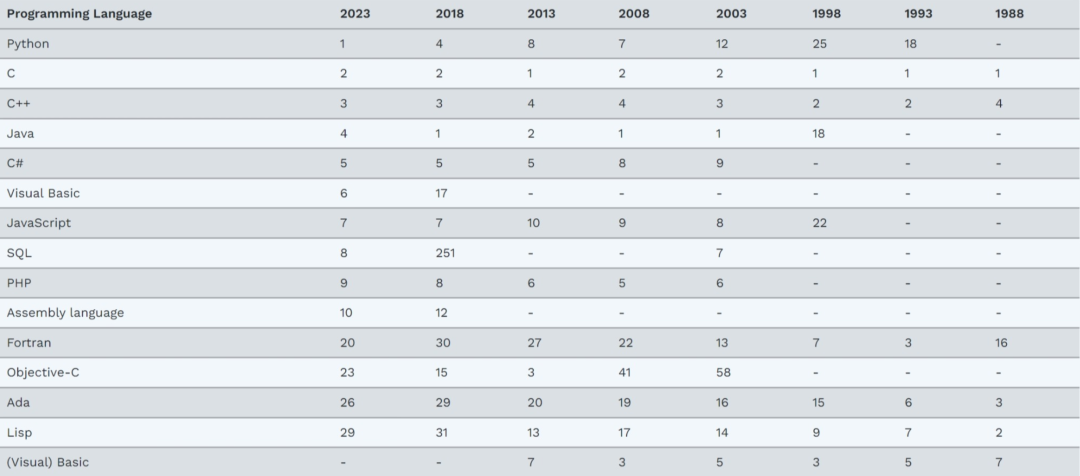

Programming Language "Celebrity List" (2003-2022)

【illustrate】:
The TIOBE programming language community ranking is an indicator of programming language popularity trends, updated monthly. The ranking is based on the number of technical engineers, courses and third-party vendors around the world, including popular search engines and technical communities, such as Google, Baidu, Wikipedia, CSDN, Bing, Hao 123, etc. For detailed calculation methods, please see: https://www.tiobe.com/tiobe-index/programming-languages-definition/. Please note that this ranking only reflects the popularity of a programming language, and does not indicate whether a programming language is good or not, or how much code is written in a language.
This ranking can be used to examine whether your programming skills are keeping pace with the times, and can also be used as a basis for language selection when developing new systems.
For detailed list information, please refer to TIOBE official website: https://www.tiobe.com/tiobe-index
digression
Many people who are new to the computer industry or graduates of computer-related majors from universities encounter difficulties in finding employment due to lack of practical experience. Let's look at two sets of data:
-
The number of college graduates nationwide in 2023 is expected to reach 11.58 million, and the employment situation is grim;
-
Data released during the National Cyber Security Awareness Week show that by 2027, the shortage of cyber security personnel in our country will reach 3.27 million.
On the one hand, the employment situation for fresh graduates is grim every year, and on the other hand, there is a shortage of one million cybersecurity talents.
On June 9, Max Research’s 2023 Employment Blue Book (including the “2023 China Undergraduate Employment Report” and “2023 China Higher Vocational Students Employment Report”) was officially released.
The top 10 majors with the highest monthly income for college graduates in 2022
Undergraduate computer majors and higher vocational automation majors have higher monthly incomes. The monthly incomes of the 2022 undergraduate computer majors and higher vocational automation majors are 6,863 yuan and 5,339 yuan respectively. Among them, the starting salary of undergraduate computer majors is basically the same as that of the 2021 class, and the monthly income of higher vocational automation majors has increased significantly. The 2022 class overtook the railway transportation major (5,295 yuan) to rank first.
Looking at the major specifically, the major with the highest monthly income for the 2022 undergraduate class is information security (7,579 yuan). Compared with the class of 2018, undergraduate majors related to artificial intelligence such as electronic science and technology and automation performed well, with starting salaries increasing by 19% compared with five years ago. Although data science and big data technology are new majors in recent years, they have performed well and have ranked among the top three majors with the highest monthly income for 2022 undergraduate graduates six months after graduation. French, the only humanities and social sciences major that entered the top 10 highest-paying undergraduates five years ago, has dropped out of the top 10.
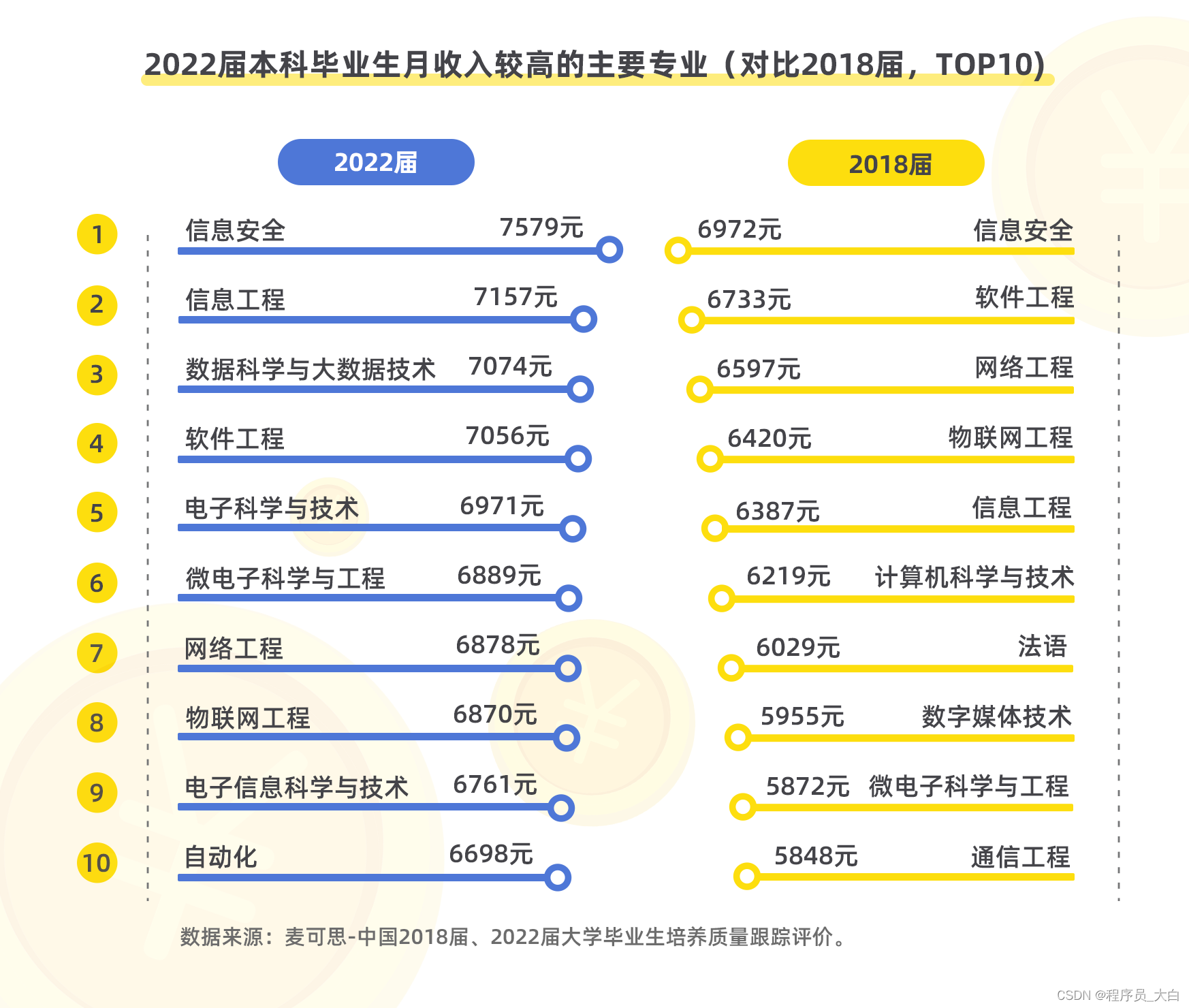
“There is no national security without cybersecurity.” At present, network security has been elevated to the level of national strategy and has become one of the most important factors affecting national security and social stability.
Characteristics of the network security industry
1. The employment salary is very high, and the salary increases quickly. In 2021, Liepin.com announced that the employment salary in the network security industry is the highest per capita in the industry, 337,700!
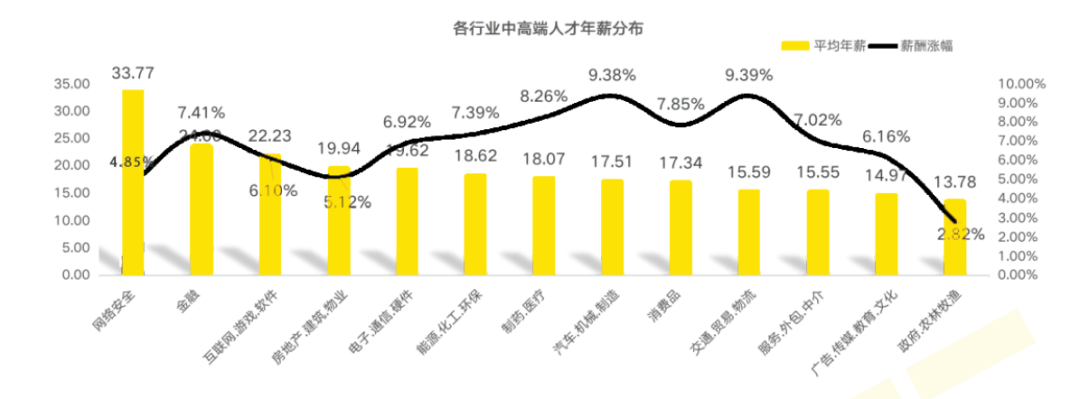
2. There is a large talent gap and many employment opportunities
On September 18, 2019, the official website of the "Central People's Government of the People's Republic of China" published: my country's demand for cyberspace security talents is 1.4 million, but major schools across the country train less than 1.5 million people every year. Liepin.com’s “Cybersecurity Report for the First Half of 2021” predicts that the demand for network security talents in 2027 will be 3 million. Currently, there are only 100,000 employees engaged in the network security industry.

The industry has huge room for development and there are many jobs
Since the establishment of the network security industry, dozens of new network security industry positions have been added: network security experts, network security analysts, security consultants, network security engineers, security architects, security operation and maintenance engineers, penetration engineers, information security management Officer, data security engineer, network security operations engineer, network security emergency response engineer, data appraiser, network security product manager, network security service engineer, network security trainer, network security auditor, threat intelligence analysis engineer, disaster recovery professional , Practical attack and defense professionals...
Great career value-added potential
The network security major has strong technical characteristics, especially mastering the core network architecture and security technologies at work, which has an irreplaceable competitive advantage in career development.
As personal abilities continue to improve, the professional value of the work they do will also increase with the enrichment of their experience and the maturity of project operations, and the room for appreciation will continue to increase. This is the main reason why it is popular with everyone.
To a certain extent, in the field of network security, just like the medical profession, the older you get, the more popular you become. Because the technology becomes more mature, your work will naturally be taken seriously, and promotion and salary increases will come naturally.
How to learn hacking & network security
As long as you like my article today, my private network security learning materials will be shared with you for free. Come and see what is available.
1. Learning roadmap

There are a lot of things to learn about attack and defense. I have written down the specific things you need to learn in the road map above. If you can complete them, you will have no problem getting a job or taking on a private job.
2. Video tutorial
Although there are many learning resources on the Internet, they are basically incomplete. This is an Internet security video tutorial I recorded myself. I have accompanying video explanations for every knowledge point in the roadmap above.
The content covers the study of network security laws, network security operations and other security assessments, penetration testing basics, detailed explanations of vulnerabilities, basic computer knowledge, etc. They are all must-know learning contents for getting started with network security.

(They are all packaged into one piece and cannot be expanded one by one. There are more than 300 episodes in total)
Due to limited space, only part of the information is displayed. You need to click on the link below to obtain it.
3. Technical documents and e-books
I also compiled the technical documents myself, including my experience and technical points in participating in large-scale network security operations, CTF, and digging SRC vulnerabilities. There are more than 200 e-books. Due to the sensitivity of the content, I will not display them one by one.

Due to limited space, only part of the information is displayed. You need to click on the link below to obtain it.
4. Toolkit, interview questions and source code
"If you want to do your job well, you must first sharpen your tools." I have summarized dozens of the most popular hacking tools for everyone. The scope of coverage mainly focuses on information collection, Android hacking tools, automation tools, phishing, etc. Interested students should not miss it.
There is also the case source code and corresponding toolkit mentioned in my video, which you can take away if needed.
Due to limited space, only part of the information is displayed. You need to click on the link below to obtain it.
Finally, here are the interview questions about network security that I have compiled over the past few years. If you are looking for a job in network security, they will definitely help you a lot.
These questions are often encountered when interviewing Sangfor, Qi Anxin, Tencent or other major companies. If you have good questions or good insights, please share them.
Reference analysis: Sangfor official website, Qi’anxin official website, Freebuf, csdn, etc.
Content features: Clear organization and graphical representation to make it easier to understand.
Summary of content: Including intranet, operating system, protocol, penetration testing, security service, vulnerability, injection, XSS, CSRF, SSRF, file upload, file download, file inclusion, XXE, logical vulnerability, tools, SQLmap, NMAP, BP, MSF…

Due to limited space, only part of the information is displayed. You need to click on the link below to obtain it.